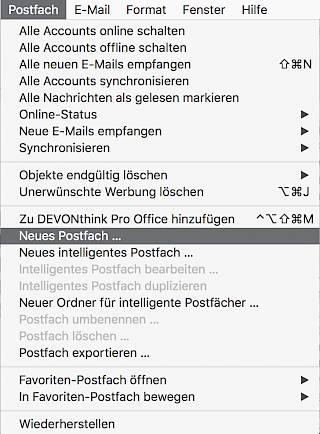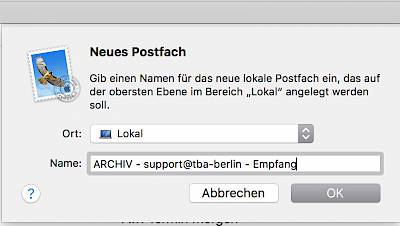Email box full?
If your email inbox overflows, you don’t have to delete your emails, you can simply archive them. How this is done step-by-step, you will learn here with the example of the e-mail program from Apple: Mail. The basic principle also applies to other e-mail programs (PC).
This article is currently under revision!
Preliminary info: statutory retention obligation according to GoBD
E-mail retention obligation according to GoBD – What is it about?
More and more invoices are sent and received by e-mail. There are statutory retention obligations for this, as well as for so-called “commercial letters” sent by e-mail (relate to specific commercial transactions, Section 257 (2) HGB). E-mails that are not related to commercial transactions do not need to be retained, e.g. also pure advertising. Internal e-mail correspondence must also only be retained if it concerns business between companies, i.e. if it is tax-related. The topic “Retention obligations according to GoBD” can be read in detail and legally well-founded e.g. here and here (…or use Google).
Retention obligations exist not only for companies that are required to keep accounts, but also for self-employed persons, freelancers and small entrepreneurs who are not required to keep accounts(source).
Since it is not always easy in everyday life to check hundreds of daily e-mails to see whether there is a concrete obligation to retain them or not, everything is often simply activated in case of doubt. The procedure conflicts with the GDPR (source), where personal data may not be stored “audit-proof” (unalterable) for a decade, e.g. applications after rejection. Theoretically, one probably has to sort out these e-mails “rule-based” (e.g. all e-mails with betriebsrat@meineFirma.de) or manually, delete them and thus exclude them from later archiving. Private mails from employees, unless they have given their express consent. (Many companies therefore have preventive company agreements that private e-mails may not even be received or written on company accounts).
Email archiving via the cloud or via your own software
Basically, the advice must be to use a special provider (cloud) and special software with which you can theoretically perform email archiving in a completely legally compliant manner. Some examples:
for APPLE / MAC
- MailArchiverX Pro
more possibilities( e.g. filter to not archive certain mails because of DSGVO) - Horcrux
especially easy to use, no exclusion filters, therefore more suitable for personal accounts
for Windows PC
Cloud offer (German Cloud according to DSGVO):
Depending on the software, you can get legally compliant archiving and also the “know-how” and the possibility to exclude data “rule-based”, which must not be archived for data protection reasons.
The following text is simply about how to free up space on your email server. Because this problem still exists, even if you do everything right with the legal backup, because it fetches emails from the server, but does not delete anything there.
Sequence steps:
- Which account type do you have? (one time)
- Set up archive (one time)
- Check memory consumption (if required)
- Archive emails (if required)
Preliminary considerations for the account type (IMAP or POP3)
a. I use my email account with IMAP:
If you use e-mail accounts of the “IMAP” type, you have many advantages. The e-mails are stored online in a central location. This way, editing (writing new emails / replying to emails, forwarding, deleting, etc.) is synchronized between the devices you use (desktop PC/Mac, mobiles, tablets), so you can seamlessly continue working on another device. However, there is one disadvantage: the mail server usually provides you with limited storage space for your e-mail account. Once this space is used up, you will not be able to receive any more emails.
Why shouldn’t so much data be online on the email server?
However, the fact that you have to keep emails does not mean that you should have your emails lying around online on your email server for years as well:
- This is predominantly problematic in terms of data protection law.
- Server space for email costs real money and is limited, as is storage space on mobile. Note the data consumption at the mobile provider to keep this data completely synchronized on the cell phone (which is automatically the case with IMAP accounts).
By the way, the seemingly free offers from Gmail, Telekom, GMX and Co. are not free either, either you “pay” with your private and business data (Google), you have to put up with advertising garbage there (GMX) or you make yourself dependent (aggravated Internet provider change). - It makes the phone and the synchronization of new data possibly slow.
Ways to reduce the amount of data on the server
- Apple Mail has an internal “Archive” function. However, this is of no use here, because it only re-sorts e-mails, but does not remove them from the server, which can still overflow.
- One possible solution would be to simply delete old emails. If you delete them in the e-mail program, they would also be deleted on the server during the next synchronization. However, one usually does not want to do this, for example, for reasons of evidence or reminders or simply because there are certain commercial storage obligations for business correspondence.
- Therefore, a much better option is to use your email program to archive old emails on your desktop computer. This means that they are still available locally there (but only there) and can also be searched there, but no longer consume storage space online on the mail server. So the computer which archives should be your main computer. A nice side effect is that these old emails are removed from the remaining devices, so e.g. the mobile phone/pad also frees up valuable storage space.Your email program on the desktop PC/Mac can namely manage both server mailboxes (data is stored on the computer and online), as well as local mailboxes (data are only on the computer). Email can be moved between them. We can use this because local mailboxes are stored only on the desktop PC/Mac. So if you move emails stored on the server to here, they disappear from the server and the space there becomes free.
b. I use my email account with POP:
For e-mail accounts of type “POP” please → continue reading here.
1. check type of e-mail account in e-mail program (necessary once).
First, go to the account settings of Apple Mail (menu “Mail” > “Settings”). There, find the email account that you want to archive. First check if the protocol “IMAP” is preset there in the settings, this is very important!
If you find out that you are using a “POP” type email account, please → continue reading here, because the following instructions refer exclusively to “IMAP” type accounts.
2. create local archive mailbox (necessary once)
In the menu under “Mailbox” select the option “New mailbox …”:
A dialog box appears.
- For “Location”, select the “Local” option
- Assign a meaningful name, e.g. “ARCHIVE – Mailbox name – Receive”, where Mailbox name represents the name of the server mailbox you want to archive. This way you can quickly find the archive again if you have multiple archives. (” – Receiving” we still hang on it, since one could archive sent e-mails after the same method, these would get accordingly the ending ” – Dispatch”).
A new folder has been created in the “Local” directory:
Nothing to see? Then the new local mailbox may be hidden. Then just hover your mouse over the word “Local” (in the left mailbox column in Apple Mail). To the right of it you will then see the word “show” in gray, please click on it.
Tip: By the way, clicking on the plus sign to the left is another way to create a new local mailbox directly at this point.
3. check the disk space used on the server (regularly)
- In the left sidebar of the program window, under the heading “Mailboxes”, expand the “Inbox” folder if collapsed (click on the small gray triangle on the left)
- Right-click on the desired email account.
- Select “Account information” in the popup menu at the bottom of the screen.
You will then see a new window showing the amount of memory used:
Now you have a good overview of how much storage space is still free and whether you need to archive if necessary. Now close this window again.
4. perform local archiving (regularly)
Now you can move the mails you want to archive to the new folder you just created:
- In the list of displayed received emails of this mailbox, click the “Sent” tab at the top of the table header. The new emails should now be at the top and the old ones at the bottom, otherwise please click “sent” again. (If “sent” is not displayed, please right-click on the table header and select the display of the “sent” column).
- So the old emails are now at the bottom. Therefore, scroll all the way down and select the bottom email. Then scroll further up back to the first email from which archiving is to be started. Click on these with the Shift key held down. This selects all emails between this email and the lowest email.
- Now drag the selected emails to the new local account ….. and WAIT.
- Apple Mail now moves the emails from the server and also moves all email attachments. Therefore, this may take some time. Please let Apple Mail run and work for a while (e.g. 5 minutes) and do not quit! How fast Apple Mail rearranges depends on the amount of moved emails, attachments and internet speed.
Ready!
Congratulations, you have just created your first local email archive!
For later archiving for this email account, perform only the last step (“4 Use the local archive”).
TIP: How about archiving your sent emails now, too? Everything goes the same way as with the received e-mails. Do not use the same mailbox as for the received e-mails, but create a new local mailbox for it and name it at the end e.g. with ” – Shipping”. Then nothing gets mixed up.
Instructions for e-mail accounts of the “POP” type
If you still use the old e-mail protocol “POP” (sometimes also called “POP3”), you have already backed up all e-mails locally in the e-mail program, as long as they are not deleted there. The memory problem on the server is also quite easy to fix:
Go to the account settings of your e-mail program. First check whether the “POP” (or “POP3”) protocol is set there. Then select there: “Delete emails permanently from server after XX days” where “XX” is usually 1 week.
In Apple mail, the setting looks like this:










